Active Office Occupancy is a method of measuring workplace usage day-to-day based on actual worker attendance rather than leased space under contract as does the traditional occupancy calculation. It provides a more dynamic view of commercial real estate demand based on occupant engagement – a useful metric in the dynamic era of hybrid work.
Traditionally, in commercial real estate, the term “occupancy” referred to how much space in an office property was leased versus how much space was potentially available as built (total leasable). In past decades, office leases had longer-term contracts of 3-10 years so that occupancy rates changed gradually over time. This was a useful metric when office demand was constant across every workweek.
The pandemic changed the frame of reference. When most people were working from home, daily office attendance almost evaporated. In that scenario, the relevant meaning of a building’s daily “occupancy” shifted in the media to reference the number of occupants who came into office buildings at all since they were largely empty, and the press needed a way to illustrate the situation to the public.
Access Control Data was the way to track this attendance-based occupancy, based on initial “card-swipe” each day. Kastle established the Back-to-Work Barometer to track this occupancy over time. Our data showed occupancy fell dramatically in the first months of the pandemic and stayed well below average for over a year but has made gradual improvement since.
While attendance continues to grow, we have seen a dramatic shift — from the traditionally consistent day-to-day office use of pre-pandemic, where there was little variation at all Monday through Friday, to that of today, where in-office attendance and occupancy levels swing dramatically across days of the week – by as much as 46% between the Tuesday peak and Friday low as shown in our Barometer data. This appears to be a more hybrid-like attendance, where work location seems to change daily between in home and in the office.
This dynamism makes it harder for property managers and office administrators to know who is in the building or office and when – and how frequently workers come in each week. In a world of hybrid schedules, this level of detail is critical in tracking occupancy, to gauge what the behavior is by office. For this level of detail, you need to gauge activity on a more individual basis to see if occupants are rarely coming in or if they have a regular routine that shows they are engaged with the location and find the office to be a relevant destination. For that, you need “Active Occupancy” data.
Active Occupancy differs from these total daily volume counts in that it differentiates attendance counts between individual user profiles so it can assess the composition of who comes when and how frequently. In other words, not treating every occupant as an identical user, but rather identifying the difference between each user’s unique access profile — something like a driver’s license number.
With a modern access control system, you can view daily access data that is attributable to a unique occupant identity associated with a tenant business, building, space, floor, etc., — you gain the data that can be sorted over time (daily, weekly, etc.) to differentiate behavioral routines by occupant.
So why do we refer to it as “Active” Occupancy? Well, it alludes to the nature of hybrid work, in that it refers to the number of “active occupants” that enter an office daily which may change dramatically day-to-day — as opposed to the traditional view of occupancy in referencing a “space” which might be empty or full day-to-day.
It’s less about how frequently or how much of the office space is being used and more about how many of the employees are using the space frequently? What share of staff come in and how often?
To learn more about how calculate active access data download our ebook here.


